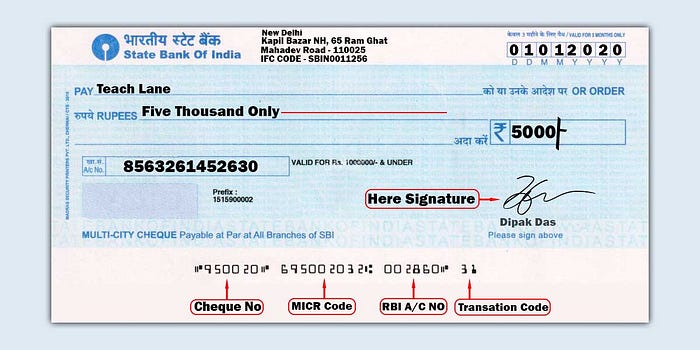10 Essential elements characteristics of cheque

Definition: Cheque refers to a negotiable instrument that contains an unconditional order to the bank to pay a certain sum mentioned in the instrument, from the drawer’s account, to the person to whom it is issued, or to the order of the specified person or the bearer.
Essential Features of a Cheque
If one takes a close look at the definition of a cheque, it becomes clear that a cheque has the following 10 essential elements or characteristics
1. Instrument in writing : A cheque must be in writing. An oral order to pay does not constitute a cheque.
2. It should be drawn on banker: It is always drawn on a specified banker. A cheque can be drawn on a bank where the drawer has an account, saving bank, or current.
3. unconditional : A cheque is an order to pay and it is not a request .The order must be unconditional.
4. The check must have an order to pay a certain sum: The cheque should contain an order to pay a certain sum of money only. If a cheque is drawn to do something in addition to, or other than to pay money, it cannot be a cheque.
5. It should be signed by the drawer and should be dated: A cheque does not carry any validity unless signed by the original drawer. It should be dated as well.
6. It is payable on demand: A cheque must be an order to pay a certain sum of money on demand but it is not necessary to the word ‘ on demand ‘ or equivalent words.
7. Validity: A cheque is normally valid for six months from the date it bears. Thereafter it is termed as stale cheque. A post-dated or antedated cheque will not be invalid. In both cases, the validity of the cheque is presumed to commence from the date mentioned on it.
8. It may be payable to the drawer himself: Cheques may be payable to the drawer himself/herself. It may be drawn payable to bearer on demand unlike a bill or a pro-note.
9 .Specific banker only : A cheque is always drawn only on a particular banker.Usually , the name & address of the banker is clearly printed on the cheque leaf itself .
10. It does not require acceptance and stamp: Unlike a bill of exchange, a cheque does not require acceptance on part of the drawee. There is, however, a custom among banks to mark cheques as ‘good’ for the purpose of clearance. But this marking is not an acceptance. Similarly, no revenue stamp is required to be affixed on cheques.
Thanks for taking out your time to read this blog.I hope you all must have gained some knowledge .
Thanks again.